Food Deserts in Arkansas
Exploring issues from the Community Foundation’s Aspire Arkansas report.





May 2023

















Exploring issues from the Community Foundation’s Aspire Arkansas report.





May 2023
















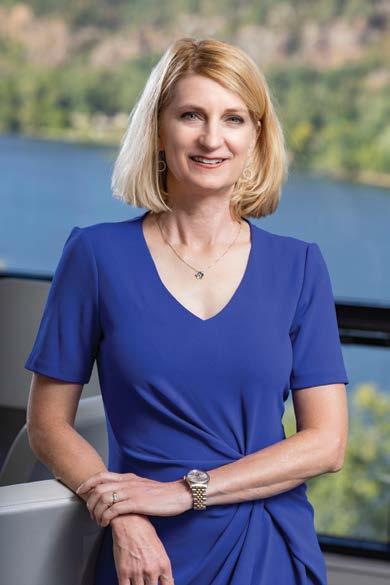
When the Kroger grocery store in Altheimer shut its doors in 2019, the area became what’s known as a “food desert” — a place without an accessible source of fresh, nutritious food. Unfortunately, this is not a problem unique to Altheimer. According to the Governor’s Food Desert Working Group report released in December 2022, 62 out of 75 counties in Arkansas have limited options to buy affordable healthy food. This isn’t just a rural problem either; the report shows that some of Arkansas’ urban areas are also affected.
Regardless of location, food deserts have a ripple effect. Arkansans living in food deserts who cannot travel long distances have little choice but to buy food at places like gas stations, mini-marts and fast food outlets. That means lots of junk food, little or no fresh food and often higher prices. A steady diet of those products can contribute to chronic health problems such as obesity, diabetes and heart disease.

Food deserts are a longstanding, entrenched problem and addressing them requires holistic solutions. Many challenges associated with poverty, food security and food deserts are interrelated. You cannot fix a food desert without addressing other factors such as economic development, early childhood literacy and community health, to name a few.
Does a sustainable model for change exist? Currently, we only have examples of working models outside of Arkansas. And while there are many people and organizations working on food deserts, solving the issue will require innovative thinking and intentional collaborations between the public and private sectors.
In this issue of ENGAGE, we explore different perspectives, the depth of the problem and some examples of progress being made. For complex challenges like food deserts, we all can play a role in helping. I encourage you to learn more about food deserts, read the governor’s report (you can click on the QR code below to find it), and educate yourself about this issue in our great state.
Arkansans Can Eradicate Food Deserts Together...........................10
Communities Unlimited Launches “Food Farmacy” in Jefferson County......11
Straight Outta Eudora — Hometown Girl Returns to Make a Difference............... 13
Investing in Food and the Future in Texarkana................................ Back Cover
Best regards,

Heather Larkin President and CEO
A Publication of Arkansas Community Foundation
President and CEO — Heather Larkin
Chief Communications Officer and Editor — Jessica Hughes Ford
Contributors — Kim Dishongh and Adena White
Designer — Lesley Cooper, Cooper Design

On the cover: James White is the director of the Elaine Legacy Center. The nonprofit was formed by descendants of Black Elaine residents.

By Kim Dishongh
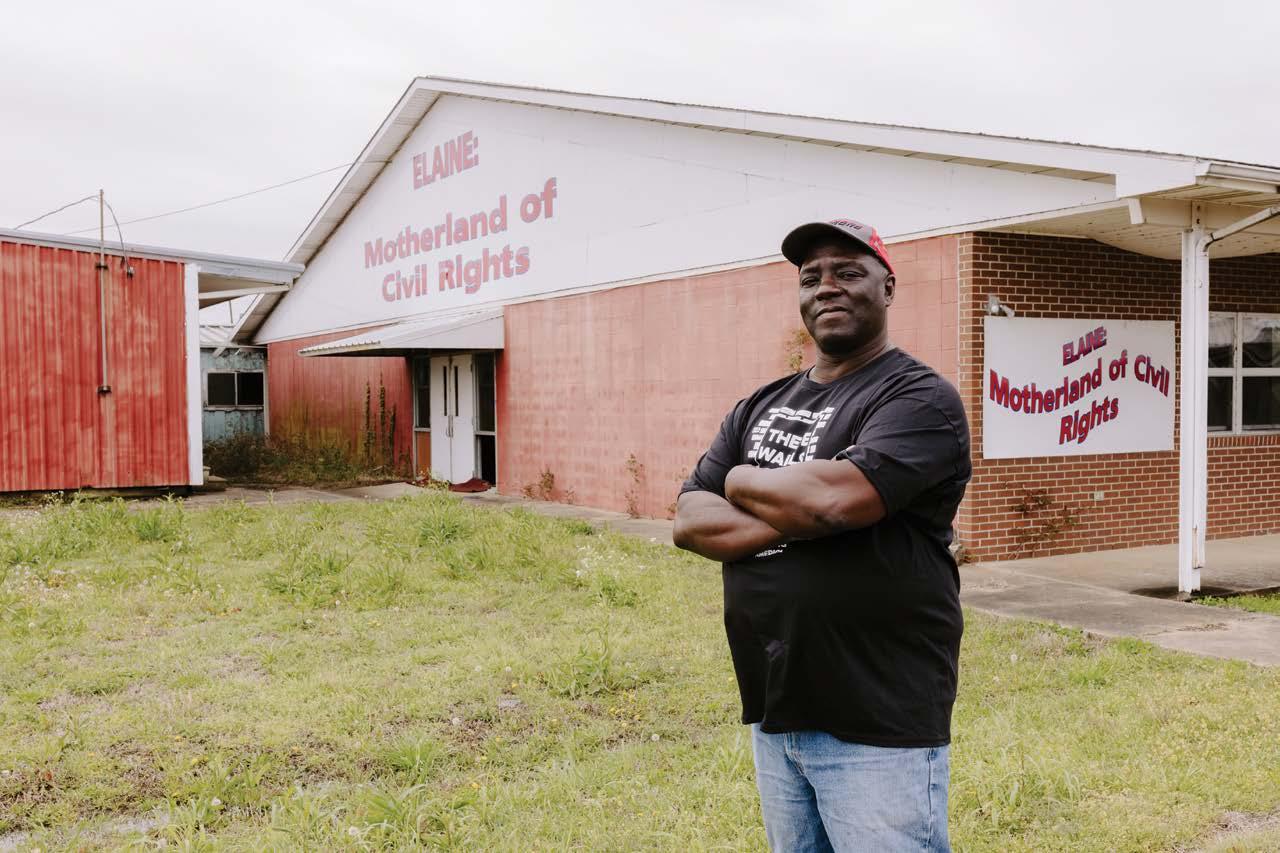
The landscape is changing in and around Elaine in Phillips County, as unkempt, often litter-strewn vacant lots are being replaced by neat rows of peas, peppers, tomatoes and more.
It makes for a more appealing view. Aesthetics aside, this evolution is helping to educate, employ and nourish residents of the little Arkansas Delta town.
James White, director of the Elaine Legacy Center, has made it his mission to improve life for the 600 or so residents of Elaine. One way to do that, he hopes, is to encourage people who own vacant lots around town to allow the Legacy Center to clear them, till them and find people to turn them into gardens.
White grew up helping his grandparents on their farm, and he formed lasting memories around the fresh produce they grew there.
“Back then, you lived off of your garden. Everybody around here used to have one,” he said. “They don’t anymore. People stopped doing that some time back.”
Not only are fewer people in Elaine growing fresh produce themselves, they often run into challenges buying it.
“From Elaine, we have to drive 20 or 30 minutes to get to a grocery store where we can get fresh vegetables,” he said. “There’s not anywhere here you can just go buy stuff like that.”
Dr. Mary Olson, spokesperson for the Legacy Center, said access to fresh whole foods is one issue, and so is poverty. Fresh produce costs more – and spoils faster – than packaged foods. People may not be able to afford the higher-priced, albeit healthier foods, and they also may not have the time or kitchen tools to prepare it.
“The mission of the Legacy Center is two-pronged,” Olson said. The nonprofit was formed by descendants of Black

Elaine residents who were killed during violence that erupted in 1919 as Black workers sought to receive better payments for the crops they harvested.
“It is, first of all, the research, preservation and sharing of the oral histories of Elaine on which to build a foundation for a poverty-free Elaine. It is also a service wing to Elaine right now that recognizes that most of the people are in poverty, and while people are still in poverty, as we wait for the heritage and tourism to eliminate it, we serve as a community. So we are big time on closing the food gap, working with teenagers and doing what the community needs to have done – and wants to have done.”
Elaine Legacy Center supporters have traditionally grown collard greens, purple hull peas and okra on their own grounds and have given much of that produce to people in the community. They also have several plots of cacti.
“Cactus is the healthiest vegetable known to humanity,” Olson said. “It is niched in the Hispanic Mexican culture and because we have a strong Hispanic population with whom we work, we started growing cactus.”
The flavor, she said, is similar to green beans, and it can be roasted, eaten raw in a salad, boiled or juiced.
“One of our goals is to get it out of just the Hispanic culture and into the general public,” said Olson.
White started a farmers' market in Elaine where smallholder farmers working in the vacant lot initiative could sell their harvests — and where Elaine residents could buy fresh fruits and vegetables locally. To increase the diversity of the market, White has occasionally traveled to other parts of the Delta to pick up produce to offer patrons. His goal is to support the farmers in the program to diversify their crops so they can grow the crops that are most in demand.
“We’re also planning for teenagers to work in the gardens this summer,” Olson said. “We are hoping that this will be so successful that some of our young people can get agricultural degrees while they are growing vegetables to make a profit. Then they can come back to Elaine earning enough money in this kind of vegetable production to make a better income here than they would make going somewhere else. So, we have high hopes for this.”
Scottie Smith of Lexa has helped plow gardens for the Elaine Legacy Center for several years. For the last couple of years, he has tended gardens of his own as well.
“I started doing it because other people had asked me to till up gardens for them,” said Smith, whose gardens are in Helena. “I had a couple of acres so I decided I would start doing it myself, too.”
Smith’s paternal grandparents farmed, and he worked on farms growing up.
“But I wasn’t growing anything when I worked on the farm,”
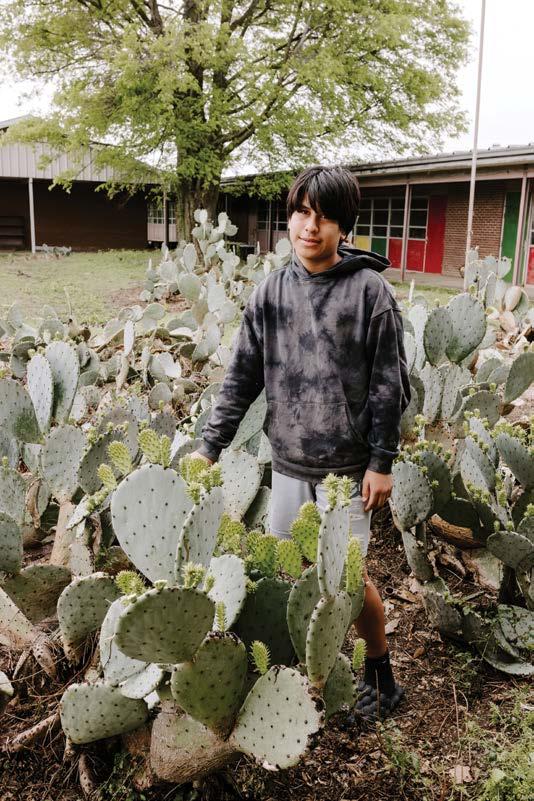
“Cactus is the healthiest vegetable known to humanity. It is niched in the Hispanic Mexican culture and because we have a strong Hispanic population with whom we work, we started growing cactus.”
— Dr. Mary Olson
he said. “I was cutting and chopping and stuff like that, but I didn’t know anything about the planting. I’m still learning that now.”
Smith, whose full-time job is driving trucks for the city of Helena/West Helena, is growing cucumbers, squash, greens, tomatoes, peppers and watermelons, and he also raises

chickens. He shares produce and eggs with people in his area who he knows need them. The pandemic and subsequent inflation have created hardships for many, he knows.
“I get to help,” Smith said. “I just try to help people get fresh vegetables in the area because there’s a lack of it here. I try to sell, and sometimes I just give it to them. Outside of that, we just try to feed our family here and keep them healthier.” Smith enlists the help of his 10-year-old son, and he hopes he will learn along with him.
“I want to make money, too, and Dr. Olson introduced me a couple of weeks ago to a guy that proposed to help us sell food to the food bank,” said Smith. “We’re looking at planting a couple of acres of just peas. I don’t know yet how that’s going to go.”
Olson expects to see more vacant lot farms this year, as well as growth in some put in in years past. There will also be a few new gardens outside Elaine, she said.
“All of us at the Elaine Legacy Center are grateful for the two years of funding from Arkansas Community Foundation,” Olson said. “This funding allows us to strengthen vacant lot farming in Elaine and expand it to other places, as well as add collaborators.”
Elaine Legacy Center received an “Access to Local Foods” grant from Arkansas Community Foundation in 2022 to help increase Arkansans’s access to locally grown food.
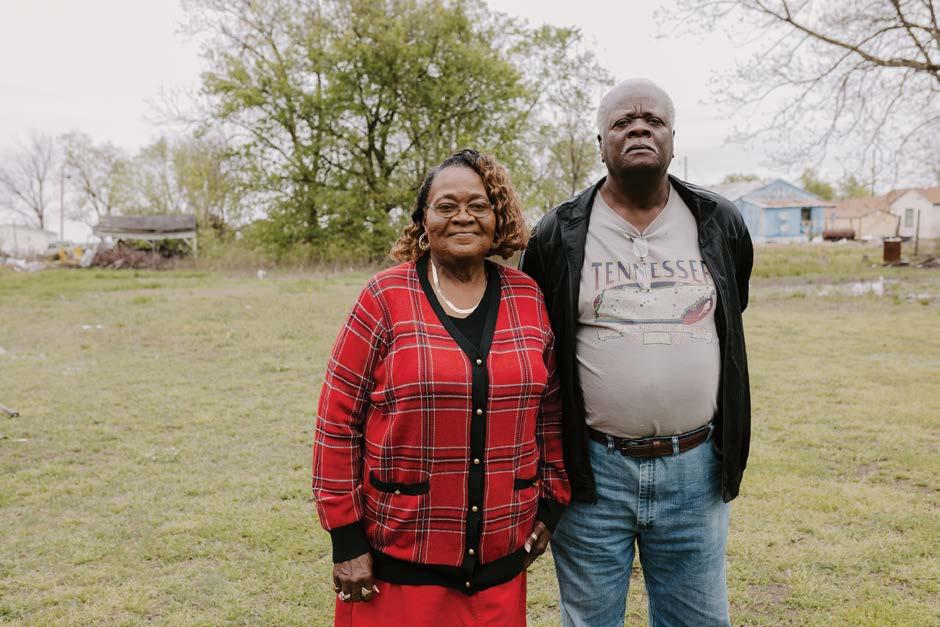
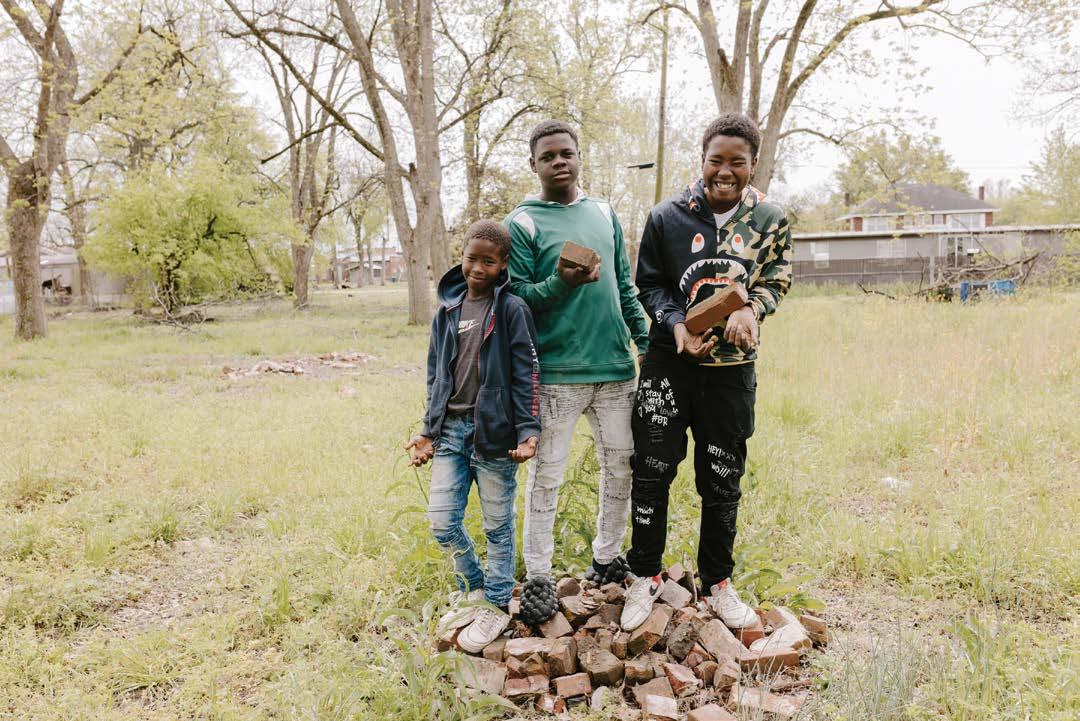
The Legacy Center is working to recruit teenagers to work in the gardens with the hope that it will spur interest in farming and keep youth from leaving the town.

By Adena J. White
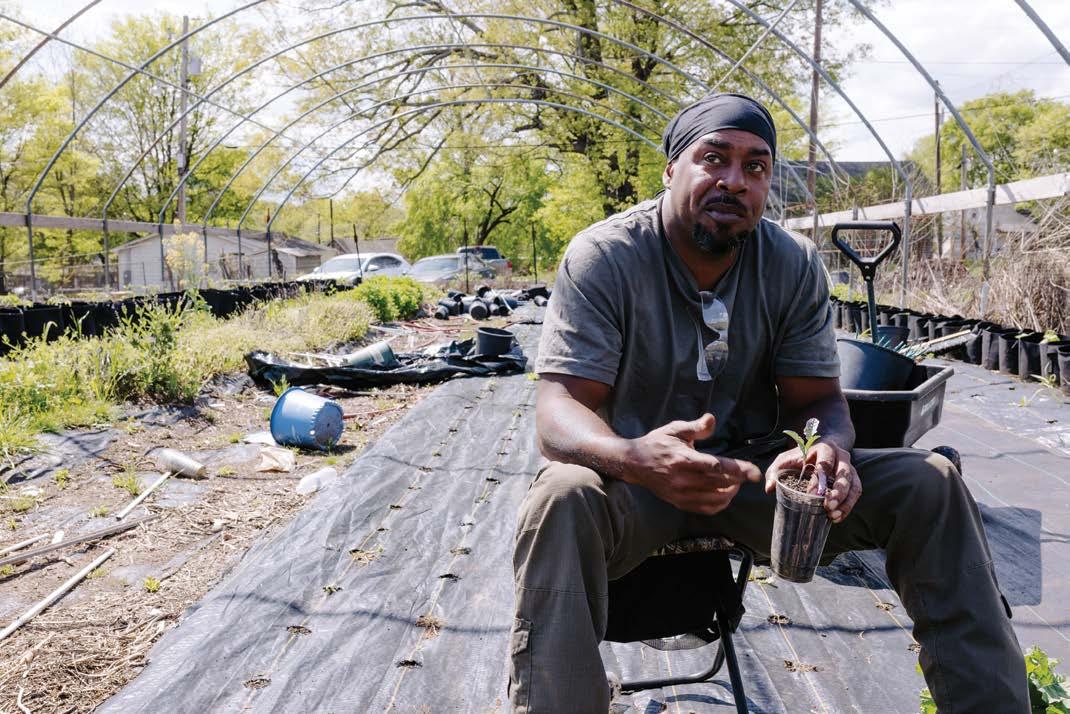
“Growing food is in my blood.”
For Gabe Bland, farming is part of his lineage. The Elaine, Arkansas, native comes from a family of sharecroppers. He calls Little Rock home, too, splitting his time between Elaine and the capital city as a child and eventually graduating from Little Rock Central High School.
Bland’s rural and urban upbringing are what fuels his passion. He uses both the process of farming and the food he produces to connect people. He is building relationships with neighbors and other community members – while educating them about urban farming practices and providing healthy foods.
Connecting the Community through Food Bland began operating his third urban farm, Turtle Island, in the South End neighborhood of Little Rock, which runs south of Roosevelt to Interstate 30, in June 2022. An experienced property manager, he saw an opportunity to
purchase lots that once housed vacant apartment buildings,transforming 3314 South Arch Street into a small farm and roadside food stand.
Through a partnership with Urban Patchwork, Bland plans to expand Turtle Island into a neighborhood food hub and commercial kitchen for growing, storing, selling and socializing around food in the South End. His vision is to bring the community together by hosting block parties, cookouts on a hibachi grill where guests can prepare and eat food grown on the farm, gardening classes and even yoga sessions.
“I want this to be more than just a store,” he said. “We want to bring people together around food.”
Urban Patchwork is a nonprofit network of farmers and backyard gardeners with a shared goal to increase access to fresh food in urban neighborhoods. For the past eight years, experienced growers like Bland who are part of the network

have provided materials, tools, hands-on learning experiences, administrative assistance and marketing opportunities to community members. Turtle Island will serve as an educational space centralizing regional resources to help people in low-income, low-access neighborhoods — as designated by the U.S. Department of Agriculture — become more self-reliant.
“The farms that are part of Urban Patchwork are not all large urban farms like Gabe’s,” said Dr. Jimmy Parks, executive director of Urban Patchwork. “Some people have small, raised-bed gardens while others may build a chicken coop in the backyard so they can have chickens and eggs. There is activity going on all over town, and we want to help remove any barriers — either real or perceived — that may prevent people from urban farming.”
While access to healthy food is important, bringing people together around food in the South End neighborhood, or any neighborhood, is an equally big part of what Urban Patchwork is all about.
“Motivating people to eat healthy food is not our objective, but I think if they’re around it, see that it tastes good and are able to have some fun growing and cooking it, they will naturally eat more of it.”
Educating Community Members about Urban Farming
Through hands-on learning experiences, Urban Patchwork aims to equip people of all ages with the skills necessary to practice sustainable urban farming. Educational opportunities include building garden beds and picnic tables, growing mushrooms, preserving food and harvesting chickens.
“We try to turn everything we do into a class,” Parks said. Community members who participate in Urban Patchwork’s learning opportunities leave with a better understanding about what is possible to produce on a small amount of land.
“You don’t have to have a lot of space to be able to produce a fair amount of food,” said Urban Patchwork board member Neil Denman. “It can be done in anybody’s yard, apartment patio or terrace, or right outside of an office. You can garden just about anywhere.”
Another benefit to educating people is to help them expand their palate. Bland said that many people buy the same produce because they may not know how to prepare foods they are unfamiliar with.
“I admit that I didn’t know what arugula was,” he said. “Even though I was eating it in a mixed salad. I want to help expose people to different types of healthy foods and teach them how they can pair and prepare them.”
Through its network of urban farms across Pulaski County, Urban Patchwork aims to expand access to fresh, local food walking distance of their home. One purpose of the project neighborhood food hub to provide local food to the 2,300
When successful, Parks expects that the community will be neighborhood. The ultimate goal is that the health of these
continued on page 7
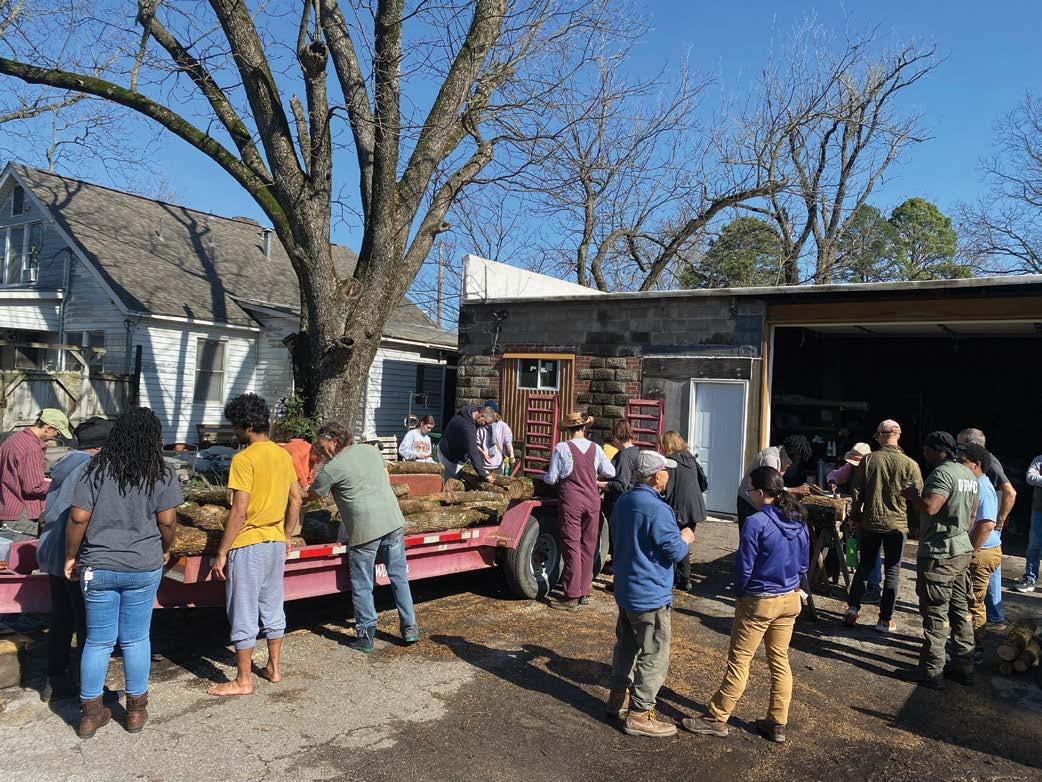


and the social cohesion – will improve as more people grow, prepare, eat and share local food.
“One reason people have limited access to local food is that they just don’t know where to get it,” Parks said.
“The Turtle Island project is a way to introduce people to one another at food- and garden-related social events in the South End neighborhood.”
Since opening nearly a year ago, Turtle Island has provided fresh, nutritious produce from more than 20 local growers to neighborhood customers. Consistent with its commitment to education, customers receive a recipe card with each purchase on how to prepare the food. The stand at Turtle Island is currently open one day a week for four hours, weather permitting, with plans to expand its hours, recruit more local food producers, and host more events and classes once the commercial kitchen is constructed.
“We want to make it a whole thing,” Bland said.


The consequences of food insecurity are being felt across the United States, but the rates in Arkansas are alarming, ranking above the national average. Unfortunately, there is no working model for addressing food deserts in the state. The 2022 Governor’s Food Desert Working Group issued a report detailing the scope of the problem, examples of promising models and recommendations for how to address the issue.

FOOD DESERT: A community is a food desert if residents must travel more than one mile in an urban setting or more than 10 miles in a rural setting to obtain a selection of fresh, nutritious food.
• 62 out of 75 Arkansas counties have one or more communities that need improved access to food.
• Traditional grocery store expansion has been stagnant in Arkansas. Since 2010, there are only two grocery stores per 10,000 people.
• There are nearly 700,000 Arkansas residents who are living in a Low-Income, Low-Access (LILA) census tract as designated by the USDA.
• Charitable food sources cannot fill the gap created by food deserts. More than 71 million meals are missing from Arkansas tables each year.
• Over 138,000 children in Arkansas receive free or reduced meals at school through the National School Lunch Program.
GROCERY DISTRIBUTION HUB: The Grocery Online Ordering Distribution Service (GOODS) in Drew, Mississippi, provides a local hub for online ordering where a full brick-and-mortar store would not be sustainable. Instead, members can order whatever food they want from their nearest Walmart and have it delivered to the GOODS location that is much closer than the nearest grocery option.
ONLINE AND DELIVERY EXPANSION: Wright’s is a family-owned grocery store in Opelika, Alabama, that has operated since 1973. They expanded their capacity to accept SNAP, provide shuttle and delivery services to customers and offer a robust online ordering platform.
GROCERY STORE AS A PUBLIC UTILITY: Erie Market is a local grocery store owned and operated by the city of Erie, Kansas. The city polled residents on the need to keep their only grocery store from closing and received enough positive support to purchase the market. It is now run by an experienced manager hired by the city and treated as a public utility.
• Mobilize community-driven, creative models to increase food access
• Create strong community partnerships
• Use integrated funding combining private and public dollars
• Increase Arkansas government accountability for improving food access
• Incorporate support for food access into state fiscal policy
• Improve access to state food benefit programs
For more detailed ideas and information on each recommendation, scan the QR code here.

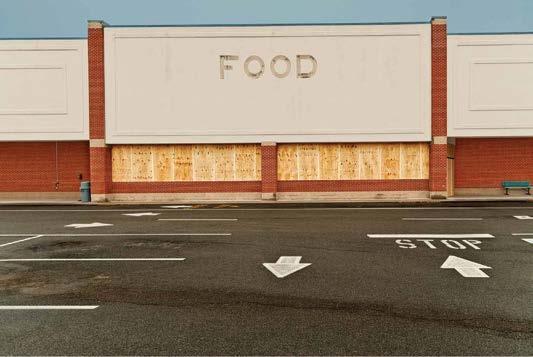

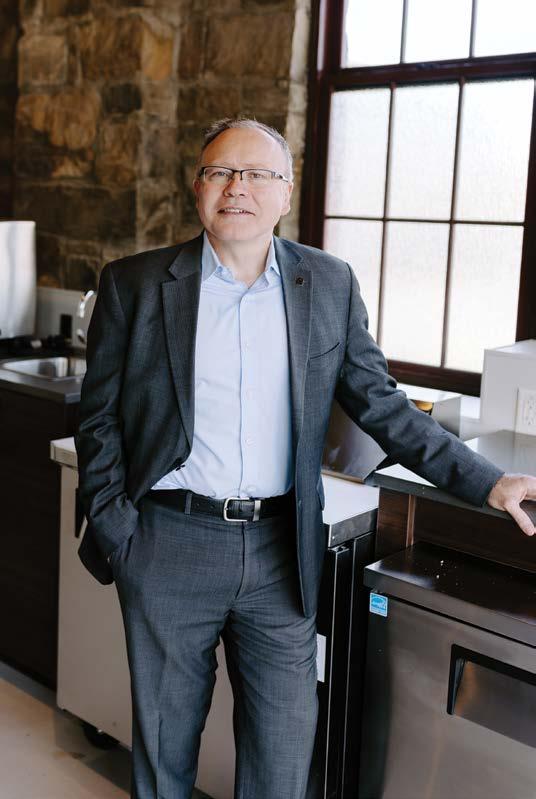
Usually when a university president discusses growth, he is referring to academics, student enrollment or budgets. Richard Dunsworth, president of the University of the Ozarks in Clarksville, has plenty to say about those topics — but he might also share updates on his crops. He put in a garden behind the president’s residence on the edge of campus and he regularly enjoys the fruits — and vegetables — of his labor.
In recent years, he has worked to cultivate partnerships geared toward making it easier for everyone in the area to access fresh, locally produced foods, and is now leading a university initiative to open a farm-to-table restaurant and taproom in a historic building within easy walking distance of campus.
“The front of the building will be a place to be able to buy fresh produce and things made and grown here in Arkansas. You can also grab a cup of coffee and a bagel and maybe some ice cream and things of that nature,” said Dunsworth. “But it’s all designed around how to support Arkansas growers and Arkansas entrepreneurs.”
“We’re partnering with our city and our chamber of commerce to locate the community farmer’s market there,” said Dunsworth.
“Let’s say you’re a small farm and you’ve got produce of some kind that you bring into the farmer’s market. You sell everything you can and then you can go into the warehouse and package it for sale in the market, or you might decide to drop it in the dehydrator or the freeze dryer so you don’t lose it,” said Dunsworth. “In many ways it’s all about knowing where your food comes from and being able to shake hands with somebody who you know produced the meat and vegetables you’re eating.”
“Dr. Kim Van Scoy, who ultimately built a sustainable agriculture minor here at the university, started a community garden,” says Dunsworth.
Van Scoy, who retired last year, called it the Food for Thought garden.
“The class decided they wanted to call the garden the Food for Thought garden because we would hopefully help provide food in our local community, which would help with the fact that we were a food desert,” said Van Scoy. One third of the produce from the garden was donated to a school backpack program, serving children in Clarksville schools, where about 70 percent of students qualified for free and reduced lunches. Another third was sold in a farmer’s market and the remainder went to the students who worked in the garden.
Dunsworth explained that the university is better situated to absorb some of the risks that, for small businesses, might be catastrophic.
“What we’re trying to do is lend our knowledge of what we know about running nonprofits, what we know about business and marketing, what we hope our students can learn in this process,” he said. “Let us be the hub that just puts a whole lot of spokes out there and supports small farms that are kind of a side gig, a secondary opportunity for people to make money, and the outcome is for our students, who may not have ever understood where food really comes from to maybe understand a little bit more.”


Our neighbors deserve accessible, affordable nutrition
Op-ed by Barrett Allen, Executive Director, University District Development Corporation

Not long ago, I spoke with a Little Rock resident who, until recently, hadn’t identified that she lives in a food desert. There are grocery stores within two miles of her home, and she has reliable transportation plus enough income to purchase what she wants to eat.
However, like many Arkansans, she is concerned that individuals and families in her community — in her neighborhood — experience hardship accessing and affording nutritious food. More than 3 million people live in Arkansas, and 700,000 live in a food desert by USDA definition. Arkansas has 75 counties, and 62 of them have food deserts.
Most Arkansans would agree that a person’s zip code should not determine their life expectancy or predisposition to cancer, cardiovascular disease, diabetes, high blood pressure, obesity, etc., but in many cases, it does.
The National Institutes of Health reports that 80 percent of chronic disease is preventable through a combination of lifestyle factors including having a healthy diet. But when the closest source of fresh meat and produce is miles away from where you live and transportation options are few, eating a balanced diet becomes logistically and physically daunting. Suddenly, neighborhood convenience stores and fast-food restaurants make sense when the alternative is to go hungry.
My years of working in and for our state convinces me that Arkansans want affordable, nutritious foods to be the norm for their neighbors, not the exception. Public and private stakeholders in the state are already working to eradicate food deserts in Arkansas. As our efforts expand, there are considerations to keep top of mind.
There is no “silver bullet” approach to eradicating food deserts. As we approach the problem head-on, we will have uncomfortable conversations with passionate residents and community leaders. Many will tell you that opening a grocery store in a food desert area is part of the solution, not the entire fix.
“Food mirages” don’t solve the problem either. People want healthy food options in their communities. But if they can’t afford to shop in a new grocery store or if the food available does not support cultural dishes they enjoy, we’re just trading inaccessibility with an illusion of accessibility.
Rural and urban farmer’s markets may fill a void. Although farmer’s markets come with marketing, pricing, and outreach challenges, some are eligible to participate in Supplemental Nutrition Assistance Program (SNAP) and Special Supplemental Nutrition Program for Women, Infants, and Children (WIC). These are massive supports for many low-income households. Therefore, policymakers should aim to tweak current policies or create new ones with funding to increase the role of farmer’s markets in food deserts.
Tax-exemptions and CDFIs are part of the solution. Food deserts need the creative, frontline efforts of nonprofits and Community Development Financial Institutions collaborating with grassroots stakeholders for short and long-term solutions. Options like funding for small urban tract community farming and flexible funding products in undercapitalized neighborhoods, etc.
I unequivocally believe that together we can solve this problem. If you want to learn more or help be the start of a solution, you can participate in the first statewide food desert conference in the state September 13, 2023. To learn more, reach out either by phone 501-399-9999 or email blallen@ualr.edu.


Partnership with local growers, health clinic will provide families with healthy, locally sourced foods
By Adena White
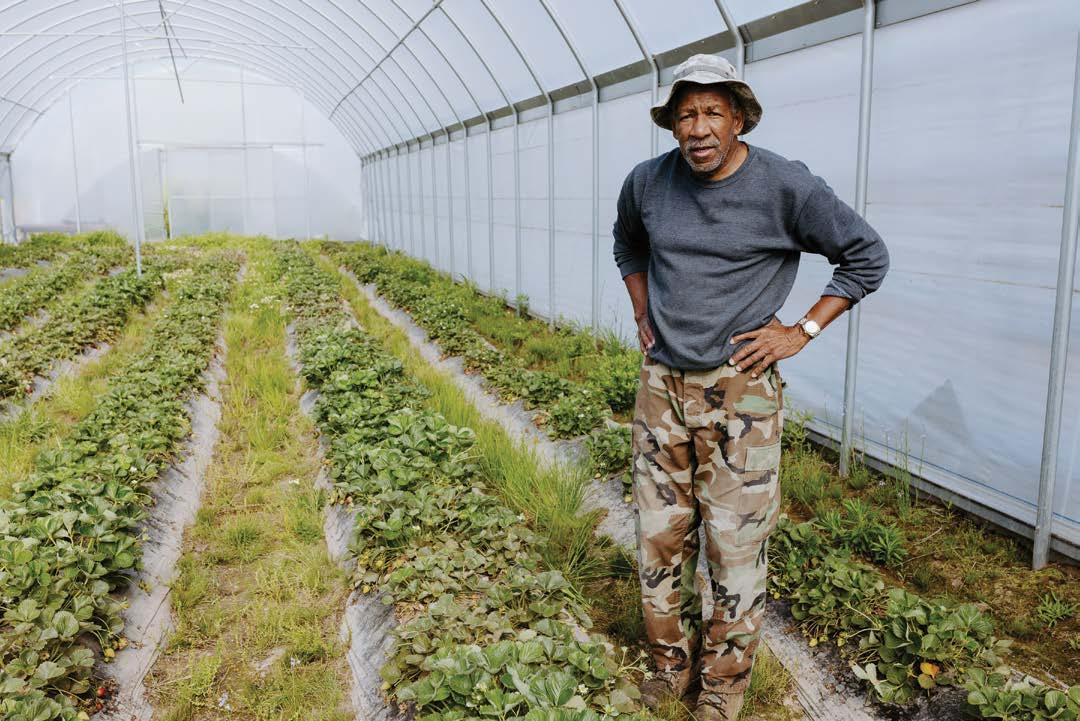
Overconsumption of processed foods has been linked to the rising rates of diabetes, hypertension and other chronic health conditions. Access and cost are the major barriers.
To address these barriers and help improve the physical and economic health of Jefferson County, Communities Unlimited was recently awarded an “Access to Local Foods”’ grant from Arkansas Community Foundation to launch a “Food Farmacy” pilot program.
This program will provide enrolled families with access to fresh, nutritious food – as well as education and healthcare services – with the ultimate goal of improving their overall health.
Part rural development hub and part community development financial institution, or CDFI, Communities Unlimited Inc. works alongside rural community leaders and small businesses to create fair access to resources needed to
sustain healthy communities, healthy businesses and healthy families.
Brenda Williams, manager of Communities Unlimited’s healthy foods initiative, wrote the grant application for the Food Farmacy project in Jefferson County, expanding upon a similar grant-funded project the organization introduced in Clarksdale, Mississippi, back in 2020. Both projects are personal to Williams, who grew up in Blytheville, Arkansas, and now lives in Mississippi.
“I definitely consider myself a Delta girl or a country girl at heart,” she said. “Every person has the right to access healthy and nutritious foods, no matter where they live.”
Through her role with Communities Unlimited, Williams works with small-scale, underserved growers, mostly Black farmers, to help them build farm capacity as well as connect them with market opportunities where they can sell wholesale. The Food Farmacy program will purchase locally grown produce from small-scale growers to provide fresh produce to families in Jefferson County.

Burthel Thomas, a local grower from Pine Bluff, is one of the farmers partnering with Communities Unlimited on the Food Farmacy initiative. The Dumas native did not grow up on a farm but has always aspired to farm and own land. He turned his dream into a reality and now owns 275 acres in Jefferson County near Wabbaseka and Altheimer.
Through the partnership with Communities Unlimited, Thomas and other small-scale farmers in the area can obtain additional market opportunities while supplying people in their community with healthy foods.
“The Food Farmacy project is a win-win for me and my neighbors who farm because we can partner with each other. It improves our ability to market and provides more food to people on a larger scale,” Thomas said.
Beginning this summer, the farmers will provide an assortment of fresh produce – including sweet potatoes, tomatoes and sweet corn — to select Jefferson County residents through a local healthcare clinic in Pine Bluff. The clinic has identified 20 to 25 patients with chronic health issues to participate in the Food Farmacy program.
The 12-week pilot project will use the “food as medicine” model to address food insecurity and provide patients and their families with a produce voucher to be redeemed at the Food Farmacy for locally grown produce. Similar to a traditional pharmacy, the idea behind the Food Farmacy is to write patients a “prescription” to eat healthy foods to improve their health and help them better manage their underlying health conditions. It will also incorporate services that include behavior-change coaching along with cooking demonstrations by nutrition educators to support patients in the development of healthy eating habits.
“Our aim with this pilot is to help bridge the divide between food insecurity and healthcare by providing healthy foods, clinical services and nutrition education to patients,” Williams said. “We definitely want to provide nutrition education and recipes so that we’re not just giving these families produce and telling them, ‘Now go and eat well.’ The idea is to equip them with the know-how for preparing the produce that is in their boxes.”
To measure the impact of the program on health outcomes, Communities Unlimited will collect baseline labs and biometric data at the beginning of enrollment.
“Our hope is that by providing fresh, healthy foods, we will see changes in behavior that will influence the health of the participants in positive ways while supporting small-scale growers in Jefferson County,” Williams said.

“Every person has the right to access healthy and nutritious foods, no matter where they live.”
— Brenda Williams
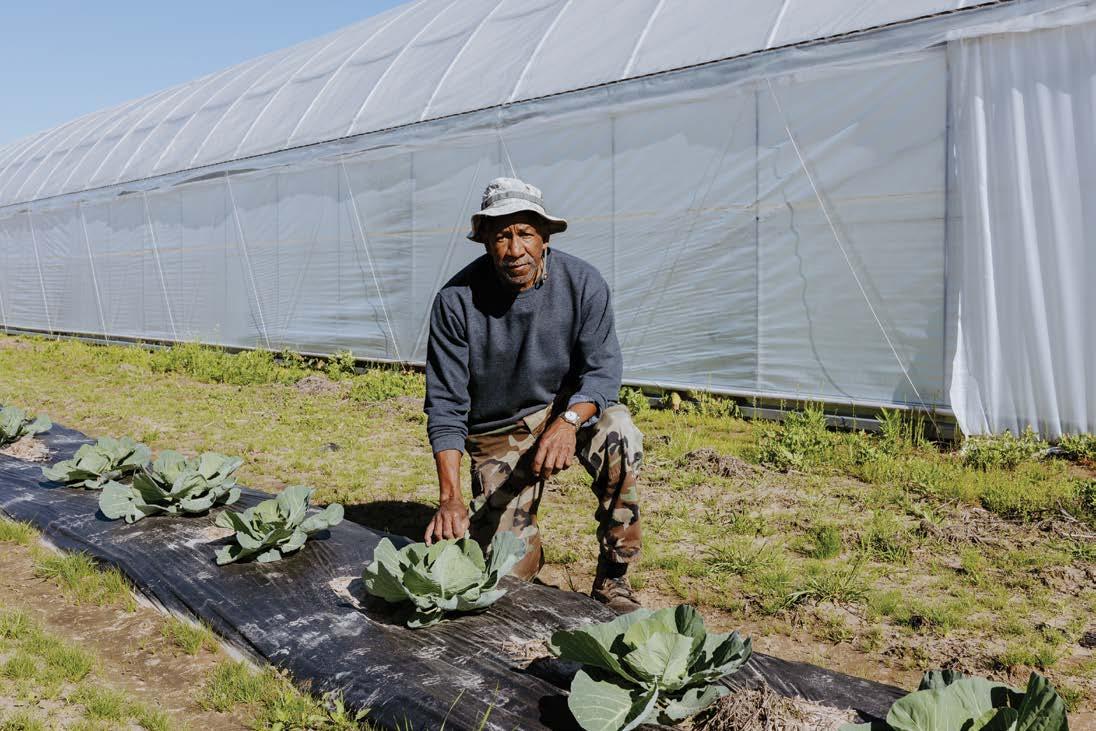

How the private sector can help solve food deserts
When Quanika Jackson left Eudora, Arkansas, to pursue a career as a healthcare provider, she knew she wanted to do big things, but she never thought those big things would bring her back home.
The youngest of 12, Jackson was raised in Eudora. Part of her childhood was spent playing at the local Sunflower Market grocery store. Over time, the store went into disrepair forcing residents to drive 20-30 miles to Oak Grove, Louisiana, for fresh food.
“I got a call a few years ago from my sister,” Jackson said. “She asked me, ‘Do you know anyone that would buy this grocery store?’”
I prayed about it, and something told me to come back. I flew home two days later and bought the dilapidated Sunflower Market building on the spot,” she said. “The old store was basically a dungeon.”
“I saw a huge need, and over time the community started
coming together to support me,” Jackson said. “We gutted the whole thing. It probably should have been torn down and rebuilt from scratch, but I wanted to preserve some of the history and bones.”
In June of 2022, Badger’s Market opened to the public. “Eudora Badger pride was lost in 2007 when the high school was closed,” she said. “My great grandmother was a Badger. We needed to bring that pride back, so I used the mascot and school colors to name and brand the store.”
Badger’s Market is not just a good grocery store for Eudora; it is a good grocery store for anywhere. Roaming the aisles, you can see Jackson’s focus on freshness. She’s also built a photo timeline at the front of the store showing the history, and future, of Eudora.
“It was important to build something that the town could be proud of,” she said. “We are always looking for local producers to keep our selection fresh and local. Our next addition will be a seafood section and coffee bar.”
Eudora has very few restaurants. After the store’s deli expanded, people started gathering there to eat — surrounded by Badger green and framed Badger jerseys.

“I think good food brings people together.”
— Quanika Jackson
“The deli has started becoming the heart of this town,” said Jackson. “I think good food brings people together.”
But the store serves more than just food. Badger’s Market employs 30 people, has a bill pay center and now offers money transfer services.
An entrepreneur at heart, Jackson splits her time between Las Vegas and Eudora running multiple businesses. Jackson bought another dilapidated building in Eudora and turned it into a beauty supply store and boutique that opened in May 2022. More recently, she refurbished two old Main Street buildings and opened an ice cream parlor and arcade. Next, she has her sights set on opening an authentic Mexican restaurant.
“Coming back home has changed me. If you told me five years ago that I’d be running a grocery store in Eudora, I would have called you crazy,” she reflected.. “But now I’m working for this whole community. I must keep this store open and keep these businesses running – for those that I employ and for the town’s economic future. I know people are grateful for this store, and I’m appreciative of that, but I’m the one that has been blessed.”



“Badger’s
Market is not just a good grocery store for Eudora; it is a good grocery store for anywhere.”
— Quanika Jackson
5 Allied Drive, Suite 51110
Little Rock, AR 72202
501-372-1116 • FAX 501-372-1166
888-220-2723 • arcf.org
ADDRESS SERVICE REQUESTED
U.S. Postage PAID
Little Rock, AR Permit No. 3141
Camille Wrinkle is the CEO and executive director at the Harvest Regional Food Bank in Texarkana. Through her leadership and experience with Arkansas Community Foundation, the organization is meeting people’s need for food now but investing in future needs too.
The food bank serves a 10-county area and has provided 4.5 million meals in the last year. “We have some of the highest number of children living in poverty in the state,” said Wrinkle. “One in four individuals that we serve is under 18 so we need a robust childhood hunger program. We provide weekend food through our Backpack Food for Kids program on 40 campuses, and we’ve started several school pantries for older students — the pantry helps meet the student’s needs, and that of their family.”
There is no indication that the food desert problem in the area will go away any time soon, so the food bank made the decision to create an organizational endowment at the Community Foundation. With their Harvest Texarkana Endowment, they supplement funding for a variety of programs including a mobile pantry and food for seniors.
“We had a small fund with the Foundation for several years and realized that it was a smart investment based on the rate of returns,” said Wrinkle. “We were looking at CDs and other investments, and we realized that increasing the endowment was the smartest move. It ensures more money in the long term.
“I think a lot of people understand the broad strokes of how a food bank works, but what they may not understand is HOW we do it and what investments are required to be sustainable,” she said.
“For example, we maintain a mobile fleet of refrigerated trucks for food distribution, but we also invest in partner agencies and make equipment grants, like commercial grade freezers and refrigerators, shelving and food storage.”
Camille Wrinkle, Harvest Regional Food Bank
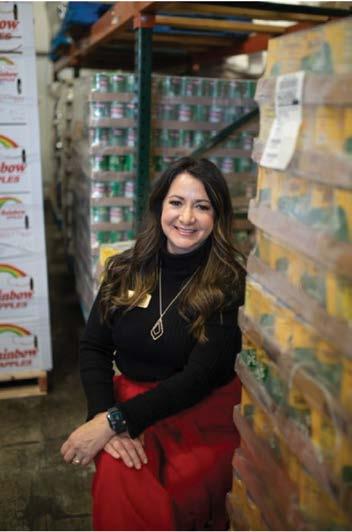
A native to the area, Wrinkle sees her work at Harvest Regional Food Bank as a way to give back to her hometown. But she credits the success of their efforts to local collaboration — from local businesses sending volunteers to help, to the infrastructure support needed for mass food distribution. “We couldn’t do this without our incredible partners,” she said. “We work with local city and county leadership, churches, private donors and businesses, and have a great group of volunteers that make this all possible.”